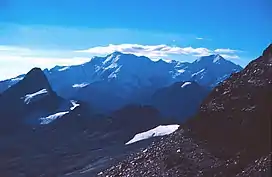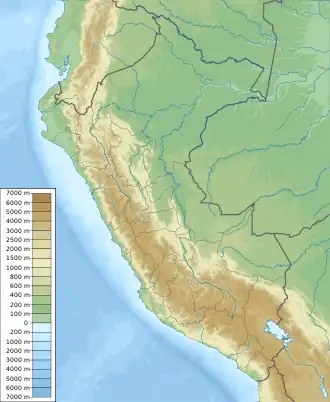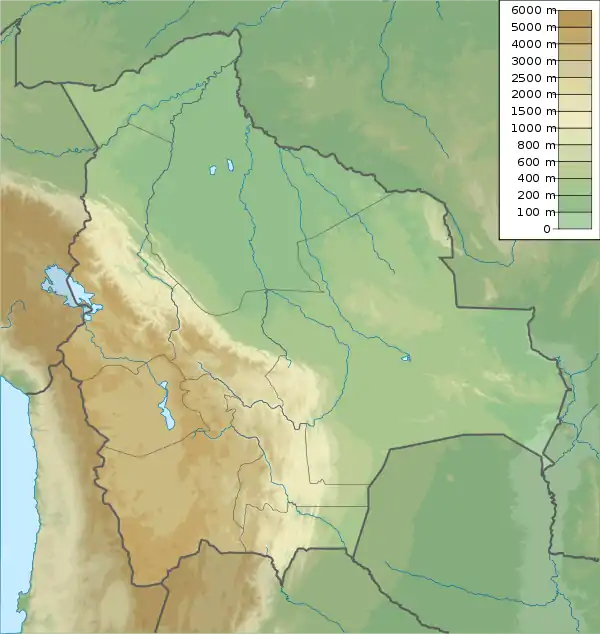| Chaupi Orco | |
|---|---|
| Viscachani | |
 Chaupi Orco from the west | |
| Highest point | |
| Elevation | 6,044 m (19,829 ft)[1][2][3] |
| Prominence | 1,537 m (5,043 ft)[1] |
| Parent peak | Ausangate (6384 m) |
| Listing | Ultra |
| Coordinates | 14°39′12″S 69°13′42″W / 14.65333°S 69.22833°W[4] |
| Geography | |
 Chaupi Orco Location in Peru on the border with Bolivia  Chaupi Orco Chaupi Orco (Bolivia) | |
| Country | Bolivia and Peru |
| Parent range | Apolobamba, Andes |
| Climbing | |
| First ascent | 1 August 1957 - Werner Karl, Hans Richter, and Hans Wimmer (Germany)[5][6] |
Chaupi Orco (possibly from the Quechua spelling Chawpi Urqu; chawpi middle, center, urqu mountain)[7] or Viscachani[4][8] (possibly from the Aymara 'wisk'acha viscacha)[9] is a mountain in the Andes on the border of Bolivia and Peru. It has a height of 6,044 metres (19,829 ft).[3] On the Bolivian side it is located in the La Paz Department, Franz Tamayo Province, Pelechuco Municipality, and on the Peruvian side it lies in the Puno Region, Putina Province, Sina District. It lies north of Salluyu.[4][10][11] Chaupi Orco is the highest peak of the Apolobamba mountain range.[12][13]
Elevation
Other data from available digital elevation models: SRTM yields 6001 metres,[14] ASTER 6028 metres,[15] ALOS 6015 metres[16] and TanDEM-X 6071 metres.[17] The height of the nearest key col is 4,489 m (14,728 ft), leading to a topographic prominence of 1,555 m (5,102 ft).[18] Chaupi Orco is considered a Mountain Range according to the Dominance System[19] and its dominance is 25.73%. Its parent peak is Ausangate and the Topographic isolation is 236 km (147 mi).[18]
First Ascent
Chaupi Orco was first climbed by Werner Karl, Hans Richter and Hans Wimmer (Germany) August 1, 1957.[5][6]
See also
References
- 1 2 "Chaupi Orcoi". Peakbagger.com. Retrieved 2010-01-30.
- ↑ "Chaupi Orco". Andes Specialists. Retrieved 2020-04-12.
- 1 2 "Topographic map of Chaupi Orco". opentopomap.org. Retrieved 2023-04-25.
- 1 2 3 escale.minedu.gob.pe - UGEL map of the Putina Province (Puno Region)
- 1 2 Pietro Meciani. Le Ande.
- 1 2 "South America, Bolivia, Cordillera Apolobamba". AAJ: 102. 1958. Retrieved 2023-04-25.
- ↑ Teofilo Laime Ajacopa (2007). Diccionario Bilingüe: Iskay simipi yuyayk’anch: Quechua – Castellano / Castellano – Quechua (PDF). La Paz, Bolivia: futatraw.ourproject.org.
- ↑ Biggar, John (2020). The Andes: A Guide for Climbers and Skiers. Andes. p. 153. ISBN 9780953608768.
- ↑ Radio San Gabriel, "Instituto Radiofonico de Promoción Aymara" (IRPA) 1993, Republicado por Instituto de las Lenguas y Literaturas Andinas-Amazónicas (ILLLA-A) 2011, Transcripción del Vocabulario de la Lengua Aymara, P. Ludovico Bertonio 1612 (Spanish-Aymara-Aymara-Spanish dictionary)
- ↑ Bolivian IGM map 1:100,000 3041 Pelechuco
- ↑ "Pelechuco". ine.gob.bo. Archived from the original on December 7, 2014. Retrieved December 13, 2014. (unnamed)
- ↑ "Catálogo GeoBolivia - GeoBolivia". geo.gob.bo. Retrieved 2020-04-30.
- ↑ PERU, Autor: GEO GPS. "Base de datos Perú - Shapefile - *.shp - MINAM - IGN - Límites Políticos". Retrieved 2020-04-30.
- ↑ USGS, EROS Archive. "USGS EROS Archive - Digital Elevation - SRTM Coverage Maps". Retrieved 12 April 2020.
- ↑ "ASTER GDEM Project". ssl.jspacesystems.or.jp. Retrieved 2020-04-14.
- ↑ "ALOS GDEM Project". ALOS EORC Jax Japan. Archived from the original on 2015-07-21. Retrieved 2020-04-14.
- ↑ TanDEM-X, TerraSAR-X. "Copernicus Space Component Data Access". Archived from the original on 12 April 2020. Retrieved 12 April 2020.
- 1 2 "Chaupi Orco". Andes Specialists. Retrieved 2020-04-12.
- ↑ "Dominance - Page 2". www.8000ers.com. Retrieved 2020-04-12.
External links